Sustainability and Leadership in Healthcare: A Formal Report
VerifiedAdded on 2023/03/31
|9
|1922
|359
Report
AI Summary
This report provides a critical analysis and evaluation of sustainability and environmental control leadership and management, with a focus on the healthcare sector. It examines contrasting approaches to sustainability based on the triple bottom line model (economic, people, and planet) and analyzes how internal management elements such as leadership, organizational strategy, professional regulation, and national policy influence sustainable healthcare. The report includes an evaluation of Rampton Hospital's sustainability practices, noting a strong emphasis on the people dimension but a lack of information on environmental sustainability. It concludes by highlighting the importance of considering all three dimensions of the triple bottom line model for effective sustainable business practices.

Running head: SUSTAINABILITY MANAGEMENT
Sustainability management
Name of the student
Name of the university
Author note
Sustainability management
Name of the student
Name of the university
Author note
Paraphrase This Document
Need a fresh take? Get an instant paraphrase of this document with our AI Paraphraser
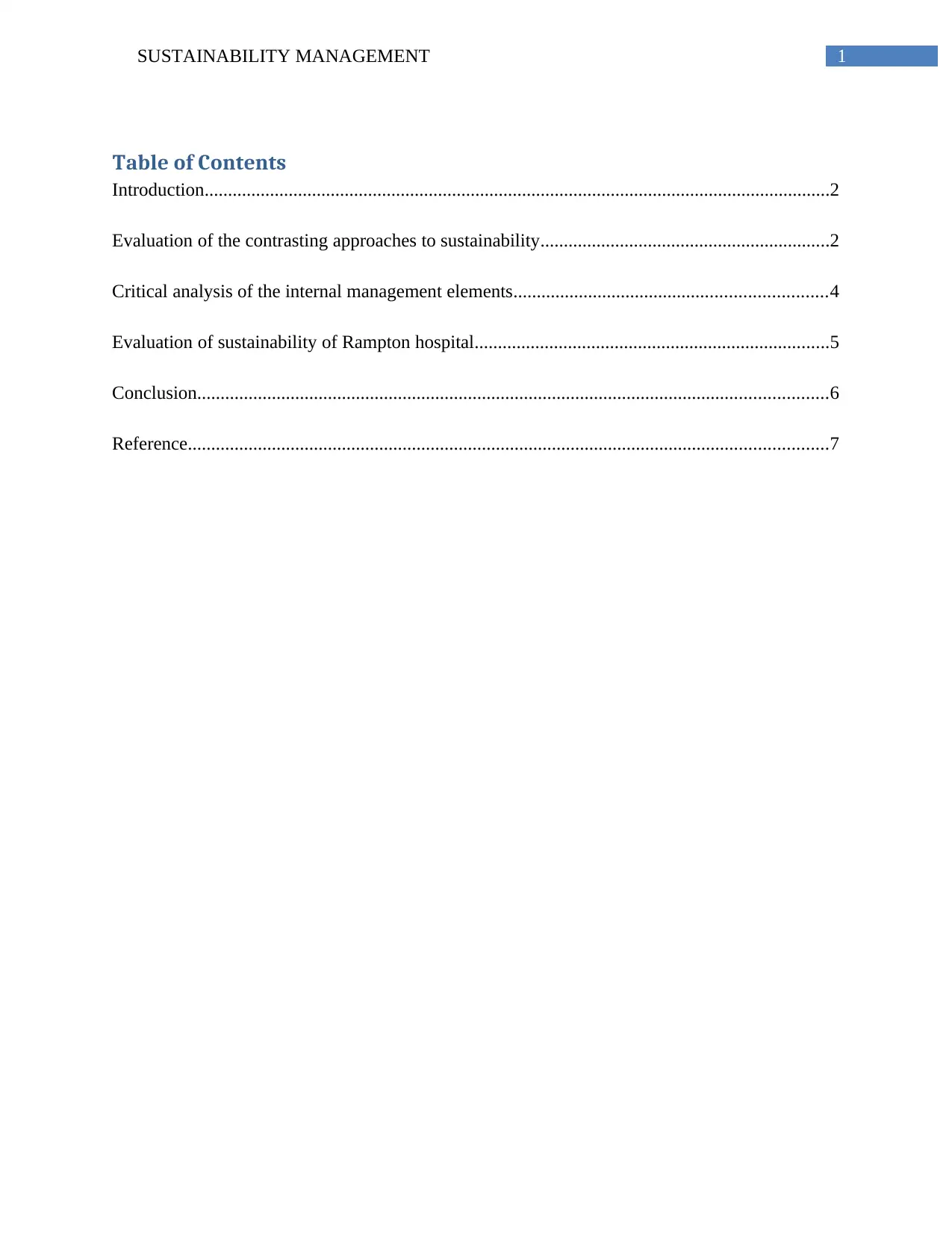
1SUSTAINABILITY MANAGEMENT
Table of Contents
Introduction......................................................................................................................................2
Evaluation of the contrasting approaches to sustainability..............................................................2
Critical analysis of the internal management elements...................................................................4
Evaluation of sustainability of Rampton hospital............................................................................5
Conclusion.......................................................................................................................................6
Reference.........................................................................................................................................7
Table of Contents
Introduction......................................................................................................................................2
Evaluation of the contrasting approaches to sustainability..............................................................2
Critical analysis of the internal management elements...................................................................4
Evaluation of sustainability of Rampton hospital............................................................................5
Conclusion.......................................................................................................................................6
Reference.........................................................................................................................................7
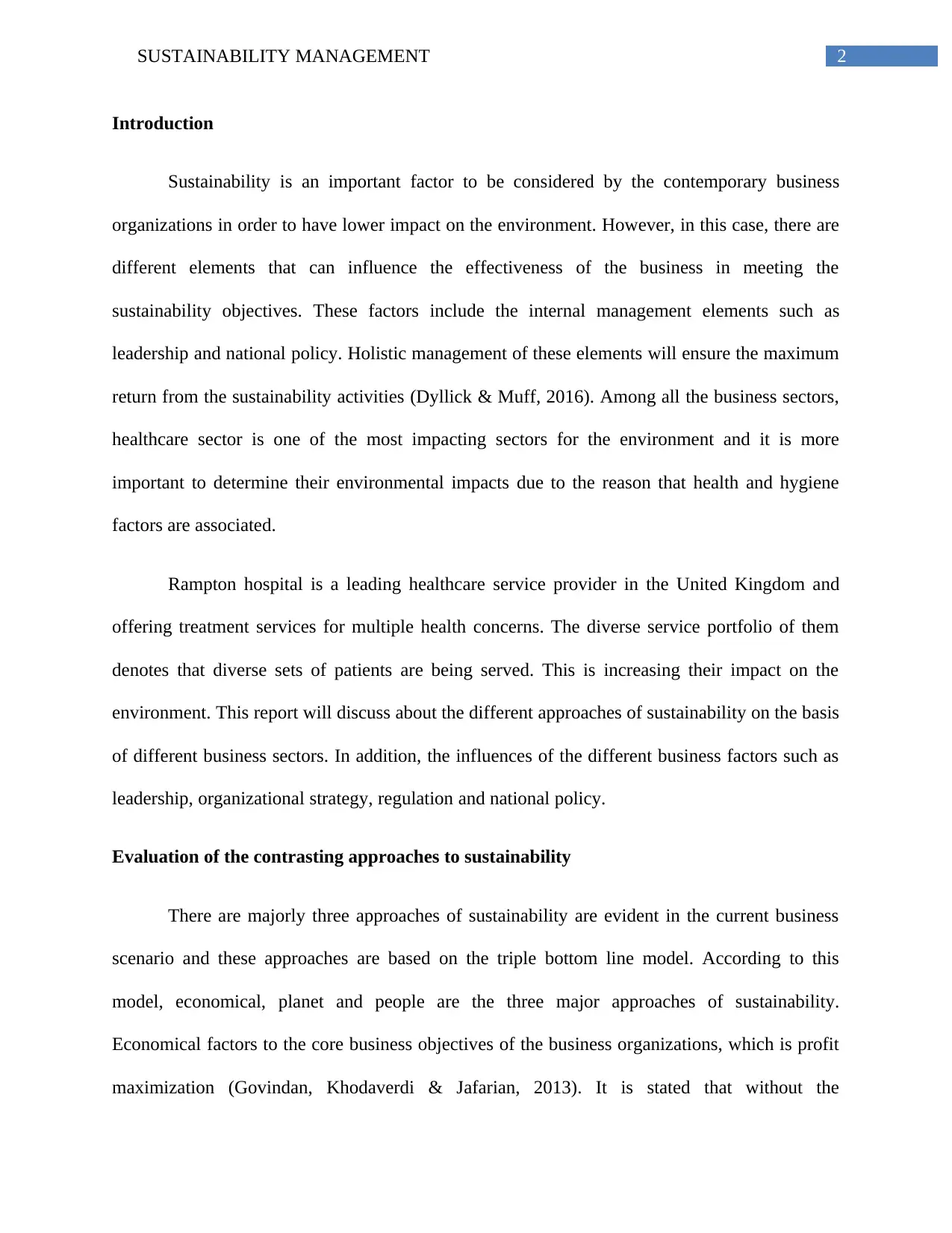
2SUSTAINABILITY MANAGEMENT
Introduction
Sustainability is an important factor to be considered by the contemporary business
organizations in order to have lower impact on the environment. However, in this case, there are
different elements that can influence the effectiveness of the business in meeting the
sustainability objectives. These factors include the internal management elements such as
leadership and national policy. Holistic management of these elements will ensure the maximum
return from the sustainability activities (Dyllick & Muff, 2016). Among all the business sectors,
healthcare sector is one of the most impacting sectors for the environment and it is more
important to determine their environmental impacts due to the reason that health and hygiene
factors are associated.
Rampton hospital is a leading healthcare service provider in the United Kingdom and
offering treatment services for multiple health concerns. The diverse service portfolio of them
denotes that diverse sets of patients are being served. This is increasing their impact on the
environment. This report will discuss about the different approaches of sustainability on the basis
of different business sectors. In addition, the influences of the different business factors such as
leadership, organizational strategy, regulation and national policy.
Evaluation of the contrasting approaches to sustainability
There are majorly three approaches of sustainability are evident in the current business
scenario and these approaches are based on the triple bottom line model. According to this
model, economical, planet and people are the three major approaches of sustainability.
Economical factors to the core business objectives of the business organizations, which is profit
maximization (Govindan, Khodaverdi & Jafarian, 2013). It is stated that without the
Introduction
Sustainability is an important factor to be considered by the contemporary business
organizations in order to have lower impact on the environment. However, in this case, there are
different elements that can influence the effectiveness of the business in meeting the
sustainability objectives. These factors include the internal management elements such as
leadership and national policy. Holistic management of these elements will ensure the maximum
return from the sustainability activities (Dyllick & Muff, 2016). Among all the business sectors,
healthcare sector is one of the most impacting sectors for the environment and it is more
important to determine their environmental impacts due to the reason that health and hygiene
factors are associated.
Rampton hospital is a leading healthcare service provider in the United Kingdom and
offering treatment services for multiple health concerns. The diverse service portfolio of them
denotes that diverse sets of patients are being served. This is increasing their impact on the
environment. This report will discuss about the different approaches of sustainability on the basis
of different business sectors. In addition, the influences of the different business factors such as
leadership, organizational strategy, regulation and national policy.
Evaluation of the contrasting approaches to sustainability
There are majorly three approaches of sustainability are evident in the current business
scenario and these approaches are based on the triple bottom line model. According to this
model, economical, planet and people are the three major approaches of sustainability.
Economical factors to the core business objectives of the business organizations, which is profit
maximization (Govindan, Khodaverdi & Jafarian, 2013). It is stated that without the
⊘ This is a preview!⊘
Do you want full access?
Subscribe today to unlock all pages.

Trusted by 1+ million students worldwide

3SUSTAINABILITY MANAGEMENT
maximization of the profits, business viability cannot be gained by the firms and they will not be
able to initiate other activities. However, on the other hand, it is also being identified that over
concentration of the profit maximization will cause lack of focus on people and planet. For
instance, in the case of food and beverage sector, the intensity and focus on the profit
maximization is more compared to other sectors such healthcare sector (Henriques, 2013). This
is due to the reason that healthcare sector is associated with the welfare of the communities,
which the food and beverage sector is not having any such social liabilities. Moreover, it should
also be noted that economical factors are the core elements for the business organizations in
managing their long term viability. However, the economical factors are not only the
determining factors in the current business scenario. For instance, healthcare sector will not be
able to gain competitiveness by only focusing on the economical factors. This is due to the fact
that if Rampton hospital cannot manage their internal and external stakeholders effectively,
profit maximization process will not be long lasting (Halpern et al., 2013). Healthcare sector is
service based sector and thus ineffective management of the people will reduce the service
process effectiveness and will affect the profit maximization.
The next approach is people that state the management of the internal and external
stakeholders in the organization. This is due to the reason that the more effective will be the
management of the stakeholders, the more will be their performance and productivity in the
workplace. This will ensure the enhancement of the service delivery process. On the other hand,
determination of the people also includes the external stakeholders (Anderson et al., 2015). This
is important due to the reason that value proposition for the external stakeholders should be
proper and meet the expectations. In the case of the meeting the expectations of the customers,
the probability of gaining positive economical trend will be more and vice versa. This is due to
maximization of the profits, business viability cannot be gained by the firms and they will not be
able to initiate other activities. However, on the other hand, it is also being identified that over
concentration of the profit maximization will cause lack of focus on people and planet. For
instance, in the case of food and beverage sector, the intensity and focus on the profit
maximization is more compared to other sectors such healthcare sector (Henriques, 2013). This
is due to the reason that healthcare sector is associated with the welfare of the communities,
which the food and beverage sector is not having any such social liabilities. Moreover, it should
also be noted that economical factors are the core elements for the business organizations in
managing their long term viability. However, the economical factors are not only the
determining factors in the current business scenario. For instance, healthcare sector will not be
able to gain competitiveness by only focusing on the economical factors. This is due to the fact
that if Rampton hospital cannot manage their internal and external stakeholders effectively,
profit maximization process will not be long lasting (Halpern et al., 2013). Healthcare sector is
service based sector and thus ineffective management of the people will reduce the service
process effectiveness and will affect the profit maximization.
The next approach is people that state the management of the internal and external
stakeholders in the organization. This is due to the reason that the more effective will be the
management of the stakeholders, the more will be their performance and productivity in the
workplace. This will ensure the enhancement of the service delivery process. On the other hand,
determination of the people also includes the external stakeholders (Anderson et al., 2015). This
is important due to the reason that value proposition for the external stakeholders should be
proper and meet the expectations. In the case of the meeting the expectations of the customers,
the probability of gaining positive economical trend will be more and vice versa. This is due to
Paraphrase This Document
Need a fresh take? Get an instant paraphrase of this document with our AI Paraphraser
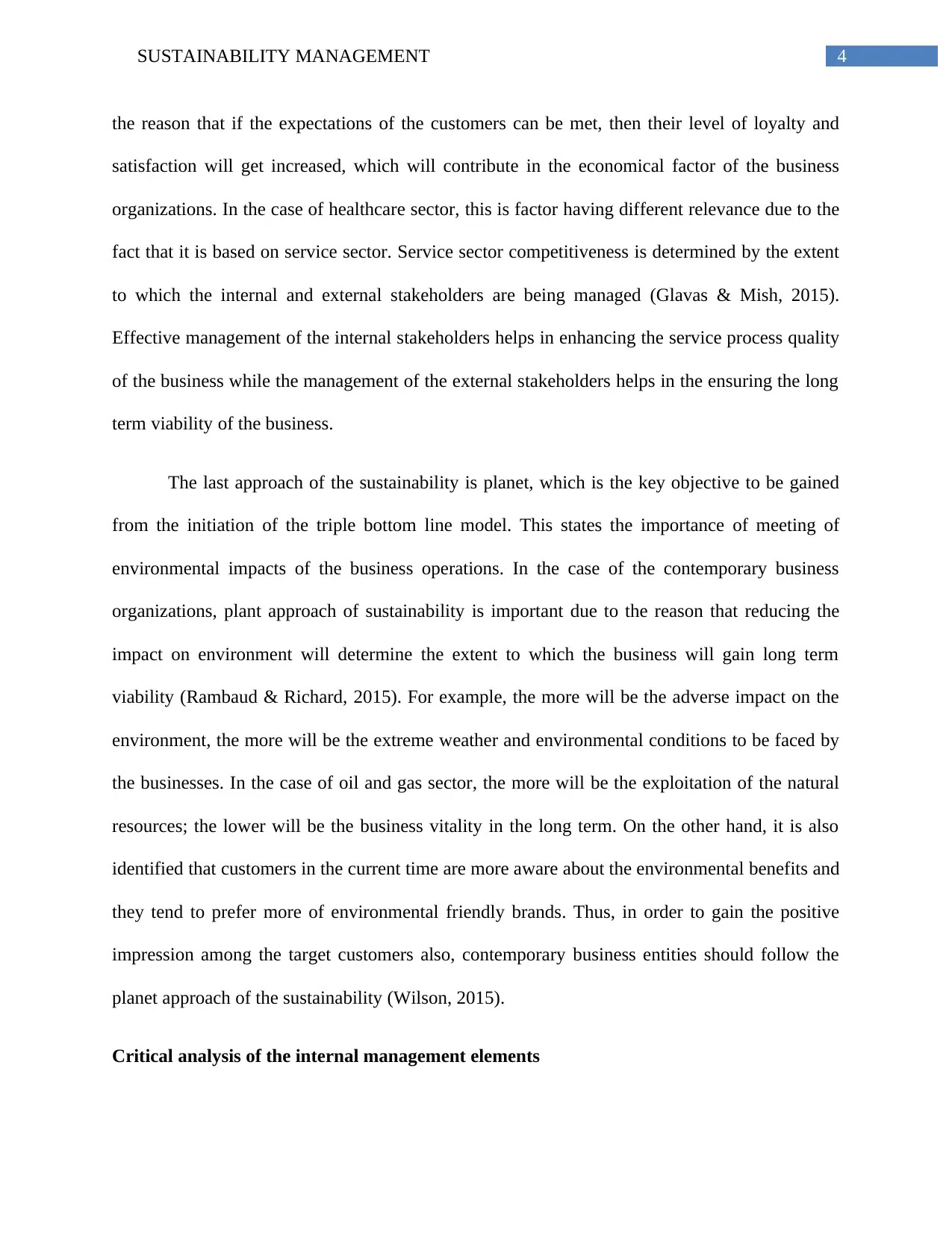
4SUSTAINABILITY MANAGEMENT
the reason that if the expectations of the customers can be met, then their level of loyalty and
satisfaction will get increased, which will contribute in the economical factor of the business
organizations. In the case of healthcare sector, this is factor having different relevance due to the
fact that it is based on service sector. Service sector competitiveness is determined by the extent
to which the internal and external stakeholders are being managed (Glavas & Mish, 2015).
Effective management of the internal stakeholders helps in enhancing the service process quality
of the business while the management of the external stakeholders helps in the ensuring the long
term viability of the business.
The last approach of the sustainability is planet, which is the key objective to be gained
from the initiation of the triple bottom line model. This states the importance of meeting of
environmental impacts of the business operations. In the case of the contemporary business
organizations, plant approach of sustainability is important due to the reason that reducing the
impact on environment will determine the extent to which the business will gain long term
viability (Rambaud & Richard, 2015). For example, the more will be the adverse impact on the
environment, the more will be the extreme weather and environmental conditions to be faced by
the businesses. In the case of oil and gas sector, the more will be the exploitation of the natural
resources; the lower will be the business vitality in the long term. On the other hand, it is also
identified that customers in the current time are more aware about the environmental benefits and
they tend to prefer more of environmental friendly brands. Thus, in order to gain the positive
impression among the target customers also, contemporary business entities should follow the
planet approach of the sustainability (Wilson, 2015).
Critical analysis of the internal management elements
the reason that if the expectations of the customers can be met, then their level of loyalty and
satisfaction will get increased, which will contribute in the economical factor of the business
organizations. In the case of healthcare sector, this is factor having different relevance due to the
fact that it is based on service sector. Service sector competitiveness is determined by the extent
to which the internal and external stakeholders are being managed (Glavas & Mish, 2015).
Effective management of the internal stakeholders helps in enhancing the service process quality
of the business while the management of the external stakeholders helps in the ensuring the long
term viability of the business.
The last approach of the sustainability is planet, which is the key objective to be gained
from the initiation of the triple bottom line model. This states the importance of meeting of
environmental impacts of the business operations. In the case of the contemporary business
organizations, plant approach of sustainability is important due to the reason that reducing the
impact on environment will determine the extent to which the business will gain long term
viability (Rambaud & Richard, 2015). For example, the more will be the adverse impact on the
environment, the more will be the extreme weather and environmental conditions to be faced by
the businesses. In the case of oil and gas sector, the more will be the exploitation of the natural
resources; the lower will be the business vitality in the long term. On the other hand, it is also
identified that customers in the current time are more aware about the environmental benefits and
they tend to prefer more of environmental friendly brands. Thus, in order to gain the positive
impression among the target customers also, contemporary business entities should follow the
planet approach of the sustainability (Wilson, 2015).
Critical analysis of the internal management elements
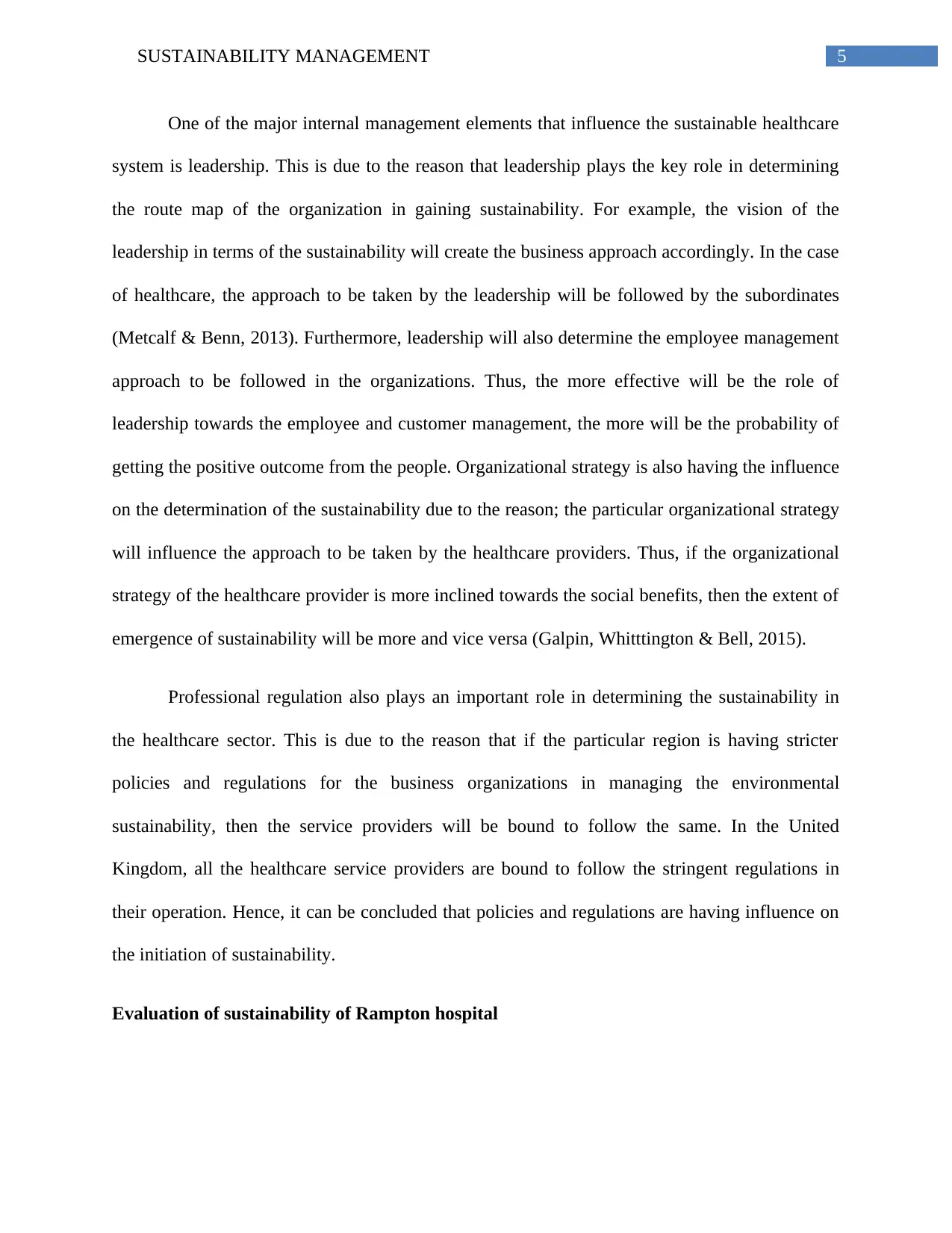
5SUSTAINABILITY MANAGEMENT
One of the major internal management elements that influence the sustainable healthcare
system is leadership. This is due to the reason that leadership plays the key role in determining
the route map of the organization in gaining sustainability. For example, the vision of the
leadership in terms of the sustainability will create the business approach accordingly. In the case
of healthcare, the approach to be taken by the leadership will be followed by the subordinates
(Metcalf & Benn, 2013). Furthermore, leadership will also determine the employee management
approach to be followed in the organizations. Thus, the more effective will be the role of
leadership towards the employee and customer management, the more will be the probability of
getting the positive outcome from the people. Organizational strategy is also having the influence
on the determination of the sustainability due to the reason; the particular organizational strategy
will influence the approach to be taken by the healthcare providers. Thus, if the organizational
strategy of the healthcare provider is more inclined towards the social benefits, then the extent of
emergence of sustainability will be more and vice versa (Galpin, Whitttington & Bell, 2015).
Professional regulation also plays an important role in determining the sustainability in
the healthcare sector. This is due to the reason that if the particular region is having stricter
policies and regulations for the business organizations in managing the environmental
sustainability, then the service providers will be bound to follow the same. In the United
Kingdom, all the healthcare service providers are bound to follow the stringent regulations in
their operation. Hence, it can be concluded that policies and regulations are having influence on
the initiation of sustainability.
Evaluation of sustainability of Rampton hospital
One of the major internal management elements that influence the sustainable healthcare
system is leadership. This is due to the reason that leadership plays the key role in determining
the route map of the organization in gaining sustainability. For example, the vision of the
leadership in terms of the sustainability will create the business approach accordingly. In the case
of healthcare, the approach to be taken by the leadership will be followed by the subordinates
(Metcalf & Benn, 2013). Furthermore, leadership will also determine the employee management
approach to be followed in the organizations. Thus, the more effective will be the role of
leadership towards the employee and customer management, the more will be the probability of
getting the positive outcome from the people. Organizational strategy is also having the influence
on the determination of the sustainability due to the reason; the particular organizational strategy
will influence the approach to be taken by the healthcare providers. Thus, if the organizational
strategy of the healthcare provider is more inclined towards the social benefits, then the extent of
emergence of sustainability will be more and vice versa (Galpin, Whitttington & Bell, 2015).
Professional regulation also plays an important role in determining the sustainability in
the healthcare sector. This is due to the reason that if the particular region is having stricter
policies and regulations for the business organizations in managing the environmental
sustainability, then the service providers will be bound to follow the same. In the United
Kingdom, all the healthcare service providers are bound to follow the stringent regulations in
their operation. Hence, it can be concluded that policies and regulations are having influence on
the initiation of sustainability.
Evaluation of sustainability of Rampton hospital
⊘ This is a preview!⊘
Do you want full access?
Subscribe today to unlock all pages.

Trusted by 1+ million students worldwide

6SUSTAINABILITY MANAGEMENT
It is identified that Rampton hospital is following intensive approach of sustainability in
their business operation. This is due to the reason that there are no extensive data and
information available in the official website of them. It is also identified that people dimension of
sustainability is majorly focused by the Rampton hospital and information related to the people
based sustainability such as equity and diversity in the workforce is stated in their official
website (Fleiszer et al., 2013). According to the information available, Rampton hospital is
having diverse sets of employees in their workforce and thus practicing equity and diversity is
helping them in managing the coordination and cooperation between them. It is also identified
that customer centric approach in the service delivery process of Rampton hospital is proving the
point that people factor of Rampton hospital is effectively followed by them. The major
limitation that is being identified in the sustainability approach of Rampton hospital is the lack of
information of environmental sustainability (Capolongo et al., 2016). Hence, it can be concluded
that the sustainable activities of Rampton hospital are having narrow approach and not meeting
all three dimensions of the triple bottom line model.
Conclusion
This report concludes that there are number of factors that should be considered in the
initiation of the sustainable business practices. In this report, the three major dimensions of the
triple bottom line model are discussed and they are critically analyzed from the perspectives of
different business sectors. In addition, there are different internal business factors identified in
this report, that can influence the extent of sustainability and these factors are leadership,
organizational strategy and professional regulations. Critical analysis of the sustainable practices
of Rampton hospital concluded that people dimension is majorly focused and environmental
dimension is least focused.
It is identified that Rampton hospital is following intensive approach of sustainability in
their business operation. This is due to the reason that there are no extensive data and
information available in the official website of them. It is also identified that people dimension of
sustainability is majorly focused by the Rampton hospital and information related to the people
based sustainability such as equity and diversity in the workforce is stated in their official
website (Fleiszer et al., 2013). According to the information available, Rampton hospital is
having diverse sets of employees in their workforce and thus practicing equity and diversity is
helping them in managing the coordination and cooperation between them. It is also identified
that customer centric approach in the service delivery process of Rampton hospital is proving the
point that people factor of Rampton hospital is effectively followed by them. The major
limitation that is being identified in the sustainability approach of Rampton hospital is the lack of
information of environmental sustainability (Capolongo et al., 2016). Hence, it can be concluded
that the sustainable activities of Rampton hospital are having narrow approach and not meeting
all three dimensions of the triple bottom line model.
Conclusion
This report concludes that there are number of factors that should be considered in the
initiation of the sustainable business practices. In this report, the three major dimensions of the
triple bottom line model are discussed and they are critically analyzed from the perspectives of
different business sectors. In addition, there are different internal business factors identified in
this report, that can influence the extent of sustainability and these factors are leadership,
organizational strategy and professional regulations. Critical analysis of the sustainable practices
of Rampton hospital concluded that people dimension is majorly focused and environmental
dimension is least focused.
Paraphrase This Document
Need a fresh take? Get an instant paraphrase of this document with our AI Paraphraser
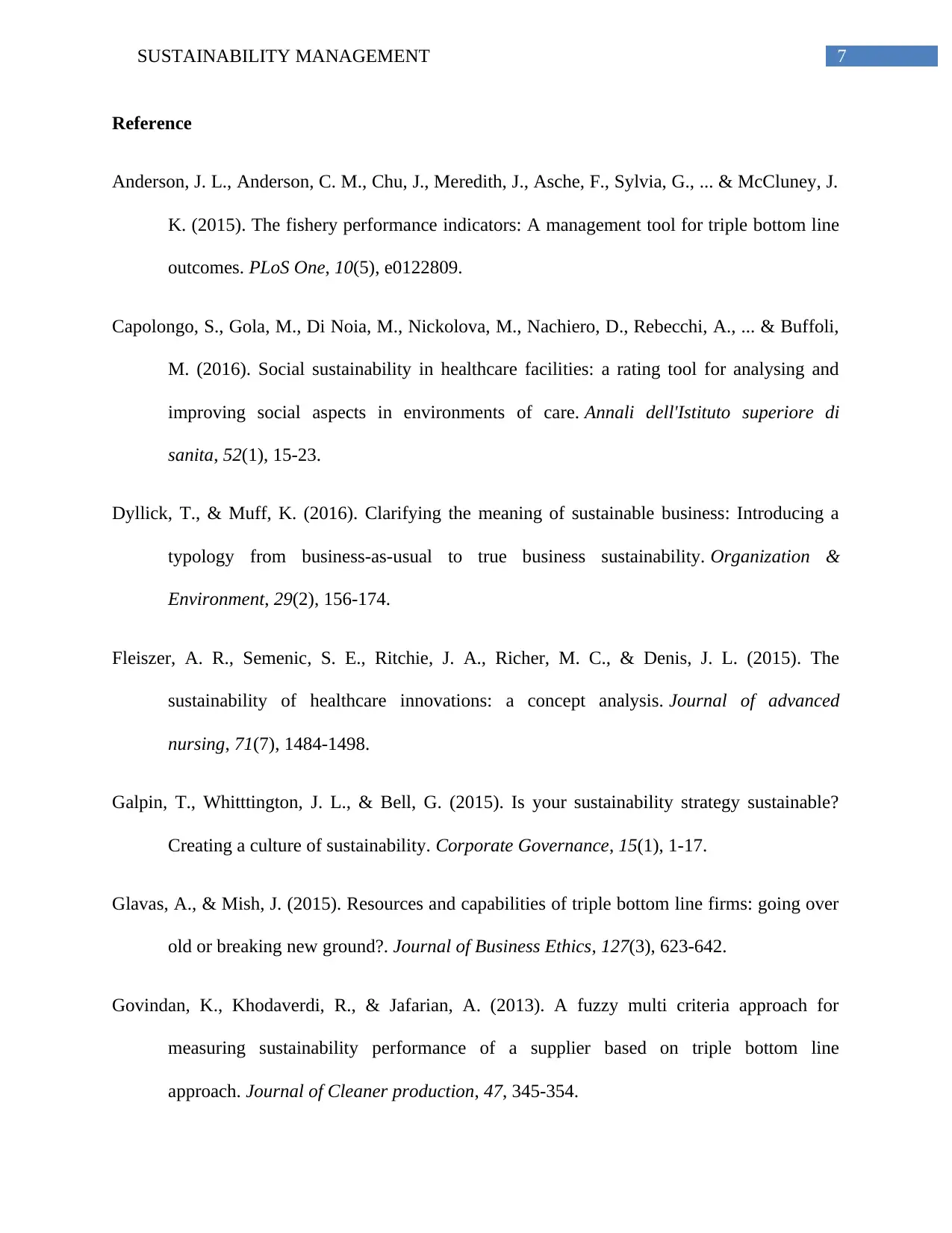
7SUSTAINABILITY MANAGEMENT
Reference
Anderson, J. L., Anderson, C. M., Chu, J., Meredith, J., Asche, F., Sylvia, G., ... & McCluney, J.
K. (2015). The fishery performance indicators: A management tool for triple bottom line
outcomes. PLoS One, 10(5), e0122809.
Capolongo, S., Gola, M., Di Noia, M., Nickolova, M., Nachiero, D., Rebecchi, A., ... & Buffoli,
M. (2016). Social sustainability in healthcare facilities: a rating tool for analysing and
improving social aspects in environments of care. Annali dell'Istituto superiore di
sanita, 52(1), 15-23.
Dyllick, T., & Muff, K. (2016). Clarifying the meaning of sustainable business: Introducing a
typology from business-as-usual to true business sustainability. Organization &
Environment, 29(2), 156-174.
Fleiszer, A. R., Semenic, S. E., Ritchie, J. A., Richer, M. C., & Denis, J. L. (2015). The
sustainability of healthcare innovations: a concept analysis. Journal of advanced
nursing, 71(7), 1484-1498.
Galpin, T., Whitttington, J. L., & Bell, G. (2015). Is your sustainability strategy sustainable?
Creating a culture of sustainability. Corporate Governance, 15(1), 1-17.
Glavas, A., & Mish, J. (2015). Resources and capabilities of triple bottom line firms: going over
old or breaking new ground?. Journal of Business Ethics, 127(3), 623-642.
Govindan, K., Khodaverdi, R., & Jafarian, A. (2013). A fuzzy multi criteria approach for
measuring sustainability performance of a supplier based on triple bottom line
approach. Journal of Cleaner production, 47, 345-354.
Reference
Anderson, J. L., Anderson, C. M., Chu, J., Meredith, J., Asche, F., Sylvia, G., ... & McCluney, J.
K. (2015). The fishery performance indicators: A management tool for triple bottom line
outcomes. PLoS One, 10(5), e0122809.
Capolongo, S., Gola, M., Di Noia, M., Nickolova, M., Nachiero, D., Rebecchi, A., ... & Buffoli,
M. (2016). Social sustainability in healthcare facilities: a rating tool for analysing and
improving social aspects in environments of care. Annali dell'Istituto superiore di
sanita, 52(1), 15-23.
Dyllick, T., & Muff, K. (2016). Clarifying the meaning of sustainable business: Introducing a
typology from business-as-usual to true business sustainability. Organization &
Environment, 29(2), 156-174.
Fleiszer, A. R., Semenic, S. E., Ritchie, J. A., Richer, M. C., & Denis, J. L. (2015). The
sustainability of healthcare innovations: a concept analysis. Journal of advanced
nursing, 71(7), 1484-1498.
Galpin, T., Whitttington, J. L., & Bell, G. (2015). Is your sustainability strategy sustainable?
Creating a culture of sustainability. Corporate Governance, 15(1), 1-17.
Glavas, A., & Mish, J. (2015). Resources and capabilities of triple bottom line firms: going over
old or breaking new ground?. Journal of Business Ethics, 127(3), 623-642.
Govindan, K., Khodaverdi, R., & Jafarian, A. (2013). A fuzzy multi criteria approach for
measuring sustainability performance of a supplier based on triple bottom line
approach. Journal of Cleaner production, 47, 345-354.

8SUSTAINABILITY MANAGEMENT
Halpern, B. S., Klein, C. J., Brown, C. J., Beger, M., Grantham, H. S., Mangubhai, S., ... &
Possingham, H. P. (2013). Achieving the triple bottom line in the face of inherent trade-
offs among social equity, economic return, and conservation. Proceedings of the National
Academy of Sciences, 110(15), 6229-6234.
Henriques, A. (2013). CSR, sustainability and the triple bottom line. In The Triple Bottom
Line (pp. 48-55). Routledge.
Metcalf, L., & Benn, S. (2013). Leadership for sustainability: An evolution of leadership
ability. Journal of Business Ethics, 112(3), 369-384.
Rambaud, A., & Richard, J. (2015). The “Triple Depreciation Line” instead of the “Triple
Bottom Line”: towards a genuine integrated reporting. Critical Perspectives on
Accounting, 33, 92-116.
Wilson, J. P. (2015). The triple bottom line: Undertaking an economic, social, and environmental
retail sustainability strategy. International Journal of Retail & Distribution
Management, 43(4/5), 432-447.
Halpern, B. S., Klein, C. J., Brown, C. J., Beger, M., Grantham, H. S., Mangubhai, S., ... &
Possingham, H. P. (2013). Achieving the triple bottom line in the face of inherent trade-
offs among social equity, economic return, and conservation. Proceedings of the National
Academy of Sciences, 110(15), 6229-6234.
Henriques, A. (2013). CSR, sustainability and the triple bottom line. In The Triple Bottom
Line (pp. 48-55). Routledge.
Metcalf, L., & Benn, S. (2013). Leadership for sustainability: An evolution of leadership
ability. Journal of Business Ethics, 112(3), 369-384.
Rambaud, A., & Richard, J. (2015). The “Triple Depreciation Line” instead of the “Triple
Bottom Line”: towards a genuine integrated reporting. Critical Perspectives on
Accounting, 33, 92-116.
Wilson, J. P. (2015). The triple bottom line: Undertaking an economic, social, and environmental
retail sustainability strategy. International Journal of Retail & Distribution
Management, 43(4/5), 432-447.
⊘ This is a preview!⊘
Do you want full access?
Subscribe today to unlock all pages.

Trusted by 1+ million students worldwide
1 out of 9
Related Documents
Your All-in-One AI-Powered Toolkit for Academic Success.
+13062052269
info@desklib.com
Available 24*7 on WhatsApp / Email
![[object Object]](/_next/static/media/star-bottom.7253800d.svg)
Unlock your academic potential
Copyright © 2020–2025 A2Z Services. All Rights Reserved. Developed and managed by ZUCOL.




